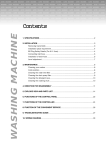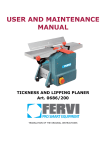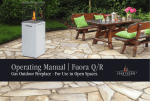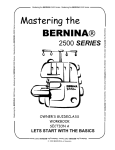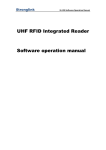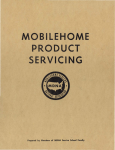Download Duerkopp Adler 7700 Instruction manual
Transcript
Instruction Manual 使用说明书 7700 High Speed Overlock Sewing Machine 高速包缝机 GB CN Installation Instructions 安装须知 Operating Instructions 操作须知 Basic Service Instructions 基本维修须知 Edition/版本:07/2006 Printed in China Part.-No./件号:0791 770741 7700 - Basic Machines 7700 - 基本机型 7704-O42-M00P Light and medium material 3-thread 1-needle standard overlock machine 薄至中厚料 3 线单针标准型包逢机 7714-B43-M00P Light and medium material 4-thread 2-needle standard overlock machine 薄至中厚料 4 线双针标准型包逢机 7716-C42-M00P Light and medium material 5-thread 2-needle safety seam machine 薄至中厚料 5 线双针标准型安全缝包逢机 Instruction Manual 使用说明书 Contents 目录 Installation Instructions 安装须知 Operating Instructions 操作须知 Basic Service Instructions 基本维修须知 Foreword This instruction manual is intended to help the user to become familiar with the machine and take advantage of its application possibilities in accordance with the recommendations. The instruction manual contains important information on how tooperate the machine securely, properly and e'conomically.Observationof the instructions eliminates danger, reduces costs for repair anddown- times, and increases the reliability and life of the machine. The instruction manual is intended to complement existing national accident prevention and environment protection regulations. The instruction manual must always be available at the machine/sewing unit. The instrction manual must be read and applied by any person that is authorized to work on the machine/sawing unit. This means: Operation, including equipping, troubleshooting during the workcycle, removing of fabric waste, Service (maintenance, inspection, repair and/or Transport. The user also hai to assure that only authorized person network onthe machine. The user is obliged to check the machine at least once per shift forapparent damages and to immediatly report any changes (includingthe performance in service), which impair the safety. The user company must ensure that the machine is only operated inperfect working order. Never remove or disable any safety devices. If safety devices need to be removed for equipping, repairing or maintaining, the safety devices must be remounted diredtly after completion of the maintenance and repair work. Unauthorized modificationof the machine rules out liability of the manufacturer for damage resulting from this. Observe all safety and danger recommendations on the machine/unit! the yellow-and-black striped surfaces designate permanend dangerareas, egdanger of squashing,cutting,shearing or collision. Besides the recommendations in this instruction manual also observe the general safety and accident prevention regulations! General safety instructions The non-observance of the following safety instructions can cause bodily injuries of damages to the machine. 1. The machine must only be ommissioned in full knowledge of the instruction book and operated by persons with appropriate training. 2. Before putting into service also read the safety rules and Instructions of the motor supplier. 3. The machine must be used only for the purpose intended. use of the machine without the safety devices is not permitted. ubserve all the relevant safety regulations. 4. When gauge parts are exchanged (e.g. needle, presser foot, needle plate,feed dog and bobbin)when threading,when the workplace is left, and during service work, the machine must be disconnected from the mains by switching off the master switch ordisconnecting the mains plug. 5. Daily servicing work must be carried out only by appropriately trained persons. 6. Repairs, conversion and special maintenance work must only be carried out by technicians or persons with appropriate training. 7. For service or repair work on pneumatic systems, disconnect the machine from the compressed air supply system ( max. 7-10 bar).Before disconnecting, reduce the pressure of the maintenance unit. Exceptions to this are only adjustments and functions checks made by appropriately trained technicians. 8. Work on the electrical equipment must be carried out only by electricians or appropriately trained persons. 9. Work on parts and systems under electric current is not permitted , except as specified in regulations DIN VDE 0105. 10. Conversion or changes to the machine must be authorized by us and made only in adherence to all safety regulations. 11. For repairs, only replacement parts approved by us must be used. 12. Commissioning of the sewing head is prohibited until such tim e as the entire sewing unit is found to comply with EC directives. It is absolutely necessary to respect the safety instructions marked by these signs. Danger of bodily injuries! Please note also the general safety instructions. ! FOR SAFE OPERATION So as to avoid electric shock hazards, do not open the cover of the electrical box of the motor or touch any part inside the electrical box with the power to the machine turned ON. To prevent possible personal injury, never operate the machine with the belt cover and the eye guard removed. To protect against possible personal injury resulting from being caught in the motor, use a motor that is provided with a motor pulley cover. To avoid electric shock hazards, never operate the machine with the ground wire for the power supply removed. During operation, be careful not to allow your or any other person's head, hands or fingers to come close to the handwheel, V belt and motor so as to prevent possible personal injury that may occur when your hands/fingers are caught in the machine. Also, do not place anything close to them. So as to avoid possible injury to your hands and fingers, do not put any of them near the cloth cutting knife and the needle when turning the power to the machine or while the machine is in operation. To prevent possible injury to your hands and fingers, do not put any of them inside the eye guard while the machine is in operation. To avoid electric shock hazards and accidents arising from damaged electrical components, be sure to turn OFF the power switch before inserting/detaching the power plug. So as to protect against possible personal injury resulting from abrupt start of the machine, make sure to turn OFF the power to the machine when you leave your machine. In the event of a power failure, be sure to turn OFF the power to the machine to protect against possible personal injury resulting from abrupt start of the machine. So as to protect against possible personal injury resulting from abrupt start of the machine, remove the belt cover, motor pulley cover and the V belt after turning OFF the power to the machine and confirming that the sewing machine will not run even by depressing the start Before inspecting, adjusting or cleaning the machine, threading the machine head or replacing the needle, so as to protect against possible personal injury resulting from abrupt start of the machine, be sure to turn OFF the power to the machine so as to prevent an accident and confirm that the sewing machine will not operate even when depressing the foot pedal of the sewing machine. To protect against personal injury resitting from possible drop of the machine, do not carry your machine by holding the cloth plate cover by hand. Doing so may cause the cover to open or break resulting in drop hazards. SAFETY DEVICES Safety devices herein described may differ in accordance with the destination and specifications. Eye guard cover A cover to prevent the injury to the eyes, the head or the like due to the dispersion of components such as the broken needle. Safety label Finger guard A cover to prevent the injury due to the contact of fingers with the needle . Cautions on safety are described. Belt cover A cover to prevent the hands, the fingers and the clothes from being caught with the V belt. Cloth plate, Cloth plate cover Covers to prevent the injury to the hands, the fingers and hair of the head,and the damage to the clothes by being caught with the rotating shafts. Caution label for the Injury to the fingers Do not allow your hands, fingers, etc. to come close to the knife to prevent the injury caused by the knife. Looper cover A cover to prevent the injury due to the contact of hands and fingers with the thread take-up lever. CONTENTS 1. DESERIPTION OF PROPER USE............................................................................. 1 1 2. SPECIFICATIONS...................................................................................................2 2 3. INSTALLATION....................................................................................................... 3 3.1 INSTALLING THE FRAME SUPPORT PLATE.............................................................3 3.2 ATTACHING THE BELT COVER................................................................................5 3.3 INSTALLING THE PEDALS.......................................................................................5 3 3 5 5 4. PREPARATION AND OPERATION.......................................................................... 6 4.1 LUBRICATION.........................................................................................................6 4.2 CHECKING THE DIRECTION OF ROTATION...............................................................7 4.3 ATTACHING NEEDLES..............................................................................................7 4.4 THREADING THE MACHINE......................................................................................8 .4.5 ADJUSTING THE PRESSURE OF THE PRESSER FOOT AND REMOVING THE PRESSER FOOT.....................................................................9 4.6 ADJUSTING THE STITCH LENGTH...........................................................................9 4.7 ADJUSTING THE DIFFERENTIAL FEED....................................................................9 6 6 7 7 8 . 9 9 9 5. BASIC SERVICE INSTRUCTIONS........................................................................... 10 5.1 ADJUSTING THE KNIVES AND OVEREDGE WIDTH.................................................. 10 5.2 CLEANING THE MACHINE HEAD............................................................................ 10 5.3 CLEANING THE FILTER AND PUMP NET............................................................... 11 5.4 MOTOR PULLEY AND V BELT............................................................................... 11 5.5 DIMENSIONS USED TO ADJUST THE LOOPER AND THE NEEDLE GUARD................ 12 5.6 DIMENSIONS RELATED TO THE POSITION OF THE THREAD TAKE-UP AND THE LOOPER THREAD CAM(STANDARD ADJUSTMENT)................................. 14 5.7 CONVERSION TABLE OF THE NEEDLE NUMBER................................................. 15 10 10 10 11 11 12 6. TABLE CUTOUT SEMI SUBMERGED ASSEMBLY.................................................... 16 16 7. TABLE CUTOUT FULLY SUBMERGED ASSEMBLY.................................................. 17 17 14 15 1. DESERIPTION OF PROPER USE The sewing unit 7700 is designed for the sewing of light weight material which generally consists of textile fibres or leather. These material are commonly used in the garment and furnishing industries.furthermore the 7700 may also be employed to perform seams in so called technical textiles. As these applications are relatively rare and extremely varied the user is advised to evaluate any possible danger arising from such applications DURKOPP ADLER AG will be pleased to assist. .. Depending on the result of this evaluation suitable safety measures have to be taken. In general the 7700 may only be used for dry material. The material thickness must not exceed 6mm when compressed by the sewing foot. The material must not contain any hard objects as otherwise the 7700 must be operated with anneedle breakage protection shield. Such needle breakage protection shield is not available at this time. Usable threads are spun threads or bulk threads made of textile fibres with dimensions up to NM30/3. Prior to the use of other threads any possible dangers arising there from have to be evaluated andappropriate safety measures must be taken if necessary. The 7700 must only be installed and operated in a dry and clean environment. Any use in other environments may necessitate furthera measures to be agreed upon.(see EN60204-3-1; 1990) .. DURKOPP ADLER AG as a manufacturer of industrial sewing machines assume that all personnel operating our products are atleast semi - skilled and all operations and,where applicable their dangers are presumed to be known. 1 2. SPECIFICATIONS 2 3. INSTALLATION 3.1 INTALLING THE FRAME SUPPORT PLATE Semi-submerged type Attach rubber cushion 2 to frame support plate 1 2 1 Attach support plate washer 3 , support plate bolt spacer 4 , frame support plate 1 and support plate washer 3 in the written order to the machine table Then fix the frame support plate to the machine table with support plate bolt A 5 and nut 6 . 3 4 3 6 5 1 5 3 4 1 3 6 5 Install waste chute opening 7 on the front side of the Upper surface of the table , and install waste chute (upper) 8 on the bottom face of the table. 7 Install waste chute (lower) 9 on waste chute (upper) 8. The installation of the chutes can be adjusted within a length of 48 mm. 9 8 48mm 3 Fully-submerged type Attach frame support plate joint A 4 , frame support plate joint B 3 and rubber cushion 2 to frame support plate 1 . 4 2 1 3 Fix support plate bolt B 6 to the machine table Put frame support plate joint A 4 and frame support plate joint B 3 between support plate washers 5 respectively. 4 5 Install frame support plate 1 so that the cloth plate is 5 mm higher than the upper surface of the machine table. 1 5 5 5 6 3 6 5 5 6 Install waste chute stopper plate 9 on frame support plate 1 . Install waste chute (upper) 7 on waste chute stopper plate 9 . Install waste chute (lower) 8 on waste chute (upper) 7. The installation of the chutes can be adjusted within a length of 48 mm. 9 1 7 8 48 m m 4 3.2 ATTACHING THE BELT COVER Caution: Danger of injury! To protect against possible person injury due to abrupt start of the machine, be sure to start the following work after turning the power off and ascertaining that the motor is at rest. Attach belt cover 1 to the machine head. 3.3 INSTALLING THE PEDALS Caution: Danger of injury! To protect against possible person injury due to abrupt start of the machine, be sure to start the following work after turning the power off and ascertaining that the motor is at rest. Install starting pedal 1 on the left and presser lifter pedal 2 on the right as seen from the operator. 1 2 4 Use an S-shaped hook 3 to connect chain 5 of the presser lifter pedal to the hole located in the top end of presser lifting lever 4. 5 3 5 4. PREPARATION AND OPERATION To avoid malfunction and damage of the machine, confirm the following: Before you put the machine into operation for the first time after set-up, clean it thoroughly. Remove all dust gathering during transportation and oil it well. Confirm that the voiltage has been correctly set. Confirm that the power plug has been properly connected to the power supply. Never use the machine in the state where the voitage type is different from the designated one. 4.1 LUBRICATION Caution: Danger of injury! To protect against possible person injury due to abrupt start of the machine, be sure to start the following work after turning the power off and ascertaining that the motor is at rest. 1 2 Remove oil cap 1 . Pour DA32 Oil(Order No.9047 000032) into the oil reservoir. Supply oil until the oil surface reaches between the two red marke r lines when oil gauge 2 is observed from the side. (Caution) Be careful not to supply oil above the upper red marker line, or else troubles due to excessive lubrication may result. Change oil when one month has passed after the set-up of the sewing machine. Then, change oil every six months. Supply oil if the oil surface comes down under the lower marker line when observing the oil gauge from the side. (Caution) Apply two or three drops of oil to the needle bar and upper looper guide portion when operating the machine for the first time after set-up or after or after a long period of disuse. 6 4.2 CHECKING THE DIRECTION OF ROTATION The correct direction of rotation of the sewing machine is clockwise when observing the machine from the handwheel side. Never allow the machine to rotate in reverse direction. If the machine rotates counter clockwise, the oil pump will fail to function resulting in seizure. 4.3 ATTACHING NEEDLES Caution: Danger of injury! To protect against possible person injury due to abrupt start of the machine, be sure to start the following work after turning the power off and ascertaining that the motor is at rest. The standard needle is DC27 # 11/B27 Nm 75 (Order. No.9092 002700 075S). You can also use he DC x 1 needle. In this case, however, the clearance provided between the needle and the looper may be required to be adjusted. If sewing needs to be carried with a finely adjuste d thread tension, use the DC x 27 needle. 2 Bring needle clamp 1 up to the highest position. Loosen needle screw 2 , and fully insert the needle into the needle clamp hole with the needle recess facing backward as viewed from the operator's side. Tighten needle screw 2 . 1 2 2 2 1 22 2 1 7 4.4 THREADING THE MACHINE Caution: Danger of injury! To protect against possible person injury due to abrupt start of the machine, be sure to start the following work after turning the power off and ascertaining that the motor is at rest. Thread the machine as shown in the figure. (Threading diagram is pasted inside the looper cover.) 1 2 2 Caution) Raise looper thread cam thread guide 1 and perform threading. Return looper thread cam thread guide 1 to its home position and securely fix it to thread guide spring 2 . (Caution) Be sure to pass the needle thread for for double chainstich through the needle thread take-up lever. (Pass the needle thread for overlocking through the thread take-up lever located outside.) (Caution) When using an untwisted thread such as wooly nylon thread or weak Intermediate thread, donot wind it round the thread guide intermediate thread guide. 8 4.5 ADJUSTING THE PRESSURE OF THE PRESSER FOOT AND EMOVING THE PRESSER FOOT Caution: Danger of injury! To protect against possible person injury due to abrupt start of the machine, be sure to start the following work after turning the power off and ascertaining that the motor is at rest. Increase Decrease 1 Adjust the pressure of the presser foot by turning presser foot adjust screw 1. When the adjust screw is turned clockwise, the pressure will increase . When it is turned counterclockwise, the pressure will decrease. To open presser foot 2 sideward, raise the needle to the highest position of its stroke and lower presser bar lifting lever 3 . Lower 3 2 4.6 ADJUSTING THE STITCH LENGTH Caution: Danger of injury! To protect against possible person injury due to abrupt start of the machine, be sure to start the following work after turning the power off and ascertaining that the motor is at rest. 1 Slowly turn the handwheel as you keep depressing pushbutton 1 , and you will find a point at which the pushbutton goes in farther. With the above condition maintained, align the desired scale mark on the handwheel with mark 2 on the belt cover. Use the scale mark as reference Reset pushbutton 1 after setting the scale mark. 2 Depress 4.7 ADJUSTING THE DIFFERENTIAL FEED Caution: Danger of injury! To protect against possible person injury due to abrupt start of the machine, be sure to start the following work after turning the power off and ascertaining that the motor is at rest. 3 Stretching stitch Gathening stitch 2 Loosen differential feed lock nut 2 . Move differential feed adjusting lever 1 up for stretching stitch or down for g a t h e r ing stitch. When you want to move differential feed adjusting lever 1 only slightly, use differential feed fine adjustment screw 3 . when the scale mark is set to -1 , the machine will perform stretching stitch with a differential feed ratio of 1 : 0.8, and when it is set to 0 , the differential feed ratio betweenthe main feed dog and the differential feed dog will be 1 : 1 . The maximum differential feed ratio for gathering is 1 : 1.9 ( it can be set to 1 : 2.9 depending on the adjustment of the internal mechanism of the sewing machine). The scale marks beyond 0 are used as reference. 1 9 “ 5. BASIC SERVICE INSTRUCTIONS 5.1 ADJUSTING THE KNIVES AND OVEREDGE WIDTH Caution: Danger of injury! To protect against possible person injury due to abrupt start of the machine, be sure to start the following work after turning the power off and ascertaining that the motor is at rest. Height of the lower knife Loosen setscrew 2 and adjust the height of lower knife 1 so that its edge is flush with the throat plate surface. 6 4 3 Height of the upper knife Loosen setscrew 4 and perform adjustment so that upper knife 3 overlaps lower knife 1 by 0.5 to 1 mm when upper knife 3 is at its lowest position. Overedge width Overedge widths of 1.6 through 6.4 mm are provided by changing the parts or by using subclass models. (The overedge width will be slightly larger than the knife cut width.) 5 2 To change the overedge width : Loosening setscrew 5 , push lower knife 1 to the left and fix it. Loosen setscrew 6 and move upper knife 3 as required, then fix it. Lower the upper knife to its lowest point and loosen setscrew 5 . Tighten setscrew 5 when the lower knife comes in xontact with the upper knife. 1 (Caution) Be sure to tighten setscrew 5 before operating machine. After the completion of adjustment, make the knives cut a thread to make sure of sharpness of the knives. Resharpening the lower knife When the lower knife has become dull , resharpen it as shown in the figure left. 5.2 CLEANING THE MACHINE HEAD Caution: Danger of injury! To protect against possible person injury due to abrupt start of the machine, be sure to start the following work after turning the power off and ascertaining that the motor is at rest. Clear lint from inside the looper cover and the needle bar and components about one or twice a day. If not, oil may leak or the sewing material will be soiled. (caution) Do not wipe the coated surface of the machine head with lacquer thinner. Doing so will damage the coated surface. 10 5.3 CLEANING THE FILTER AND PUMP NET 2 -To use the sewing machine for an extended period of time, clean filter 1 and pump net 2periodically twice or three times a year. If the filter and pump net are clogged with dusts, the machine components may be seized or womout extraordinarily. So,carefully check the filter and pump net. -If the lubricating oil in the machine is stained, change the oil also at the time of cleaning. 1 5.4 MOTOR PULLEY AND V BELT Use a clutch motor of 1/2 HP (400W). Use an M type or a DIN 2215 standard V belt. Relations among number of revolutions of sewing machine, motor pulley, and length of V belt are as shown in the aforementioned table. Effective diameter of the handwheel of sewing machine head is 50.6 mm. 11 5.5 DIMENSIONS USED TO ADJUST THE LOOPER AND THE NEEDLE Caution: Danger of injury! To protect against possible personal injury due to abrupt start of the machine, be sure to start the following work after turning the power off and ascertaining that the motor is at rest. To avoid possible accidents due to unfamiliarity with the machine, get a maintenance man who has a good knowledge of the machine or serviceman of our distributor to adjust the machine or replace any of its parts. To avoid possible personal injury when the machine starts, it has to be ascertained in prior to the actuationof the machine that no screws are loosened and no components come in contact with one another. (Caution) The dimensions given in the table are standard ones to be used to adjust the looper. They are intended to be used for reference and should be changed more or less in accordance with the sewing products and thread to be used. E F A G D 7704 7705 E B A D 7714 A C 7716 A C B 7743 A B C D E F G 7704 11 11.8 4.8 4 7705 11 11.8 4.8 4 7714 11 11.8 4.8 4 7716 11 11.8 4.8 4 7714-O42-M09P 11 10.5 4.9 4 D53 7716- D73 -X00P 12.6 11.1 12.8 4.9 3 1.8 7743 11 9.5 11.8 4.8 4 1.8 10.1 9.5 10.1 1.8 12 clearance provided between needle and blade point of lower looper 1 Push need to this side Adjust the lower looper so that the needle is pushed by 0.05 to 0.1 mm to this side by the blade point of lower lopper in the state where the blade point of lower looper is aligned with the center of needle. Then, adjust traveling needle guard 1 so that the clearance provided between the needle and the blade point of lower looper should be 0 to0.05 mm in the state where the needle is pushed to this side by traveling needle guard 1 . For the 2-needle over lock machine , adjust both the Ieft and right needles in the same manner. Needle guard components 7704/7705/7714 7716 13 5.6 DIMENSIONS RELATED TO THE POSITION OF THE THREAD TAKE-UP AND THE LOOPER THREAD CAM (STANDARD ADJUSTMENT) Caution: Danger of injury! To protect against possible person injury due to abrupt start of the machine, be sure to start the following work after turning the power off and ascertaining that the motor is at rest. Position of the needle thread take-up lever and the needle thread guide 7704/7705 7714 7716 7743 Position at which the lower end of thread hole of the needle thread guide is aligned with the edge line of the needle thread take-up lever. (Caution) The needle thread take-up lever shall be positioned at the lower dead point. 7704-O42-M 09P (Caution) The needle thread take-up lever shall be positioned at the lower dead point. 14 Position of the looper thread take-up lever and the looper thread guide J B K A F I A C B C D E F G G K 26 22 12 6 I 27 23.5 9 E J H 68 25 44.5 22 37 26 9 8 D 26 22 24 8 26 19 15 18.5 30 26.5 12 26 H 6 10 8 27 23.5 For -042-M09P only B J L K O A E A M 7704-O42-M09P B C D 68.5 24 E F G 43 H I J K L M N O 10 17 6.8 20 23.5 35 N Dimensions of E and G are adjustmaent values when the upper looper is at rightmost point. Adjustment value for the looper thread cam (7716) Thread Make sure that the looper thread cam releases the looper thread when the needle tip is positioned _ +0.5 mm against the bottom face of the throat plate 5.7 CONVERSION TABLE OF THE NEEDLE NUMBER 15 6. TABLE CUTOUT SEMI SUBMERGE D ASSEMBLY 16 7 .TABLE CUTOUT FULLY SUBMERGE D ASSEMBLY 17
























